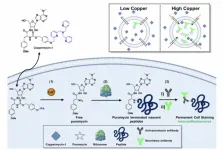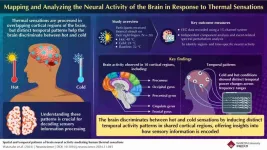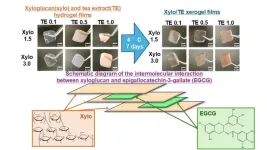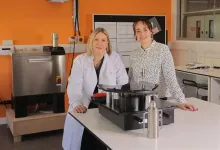(Press-News.org) The Chang Lab at Princeton Chemistry continues in its mission to elucidate the role of metal nutrients in human biology: last year, iron; this year, copper. The lab’s first paper of 2025 showcases its development of a revelatory sensing probe for the detection of copper in human cells and then wields it to uncover how copper may be regulating cell growth in lung cancer.
Researchers also offer a possible treatment modality in which copper chelation shows promising results in certain lung cancers where cells have two related phenomena: a heightened transcription factor responding to oxidative stress and a diminished level of bioavailable copper.
Their collaborative paper, A histochemical approach to activity-based copper sensing reveals cuproplasia-dependent vulnerabilities in cancer, was published this week in the Proceedings of the National Academy of Sciences. It follows on the heels of a companion July 2024 paper focusing on iron. Together, the research cements the lab’s ongoing authority in transition metal signaling.
In this latest work, the lab’s histochemical, activity-based sensing probe was deployed on a panel of human tumor cell lines from the National Cancer Institute to identify cell types with elevated levels of copper. Copper is essential to health. But copper imbalances have long been implicated in cancer cell growth and other disease states. The goldilocks balance in all mammals is so vulnerable to disruption that tools to track and assess the onset of copper-dependent cell growth, or cuproplasia, are in high demand.
“Copper is one of the most important metal nutrients for health. It’s consumed in the diet, so it’s really nature versus nurture because every cell in every organism in every kingdom of life needs it,” said Christopher Chang, the Edward and Virginia Taylor Professor of Bioorganic Chemistry. “When you think about diseases as complicated as cancer, you really want to understand the fundamentals of what causes an individual cell or collection of cells to live or die. And then you want to bring it back to something that you would use to block or kill that excess growth.
“What we need are more sophisticated biomarkers, and that’s the direction we’ve taken with this technology. We wanted a method that you could inject in many cell types in parallel, or inject in tissue, and then isolate cancer cells of different types and see which ones had a large or small dependence on cuproplasia.”
The research was carried out with chief collaborators Marco Messina at the University of Delaware and Gina DeNicola at the H. Lee Moffitt Cancer Center and Research Institute in Florida.
Connecting copper with antioxidants
The paper describes a direct link between copper and a transcription factor called nuclear factor-erythroid 2-related factor 2 (NRF2). A buildup of free radical damage in cells leads to what scientists call the antioxidant response, where NRF2 is activated and it promotes gene expression to make proteins that will combat that oxidative insult.
The Chang Lab’s work steps into this arena, bridging sensing and catalysis to map the regions where this is happening.
“Heightened levels of copper in cells are known to produce oxidative stress,” said Aidan Pezacki, co-lead author of the paper and graduate student in the Chang Lab. “So, we would expect cancers with a high demand for copper-dependent cell growth to also have higher levels of oxidative stress. Since NRF2 is directly responsible for combating oxidative stress, we thought it might be involved in regulating copper levels, as well.”
Specific lung cancers are known to have very high amounts of NRF2. Researchers were therefore able to make a connection between higher levels of NRF2 and lower levels of copper that were consequently vulnerable to copper chelation. Chelation therapy allows scientists to “grab hold of” and withhold metal nutrients, thus depriving cell growth of an important fuel.
“We took these NCI cell lines and treated them with a copper chelator and then compared cells with either low or high NRF2,” added Pezacki. “What we found was that all the cells with higher NRF2 have higher rates of cell death when we treated with the copper chelator.
“We suspect that the NRF2 is sequestering copper and then the chelator depletes the cells of copper even further, and this dual deprivation doesn’t keep up with the cell’s need for the nutrient. That makes copper chelation a potentially viable therapeutic strategy in cancers where the metal is already scarce and tightly regulated.”
Chang emphasized that results have yet to move into human tissue.
“This is a proof-of-concept study for profiling metal vulnerabilities in lung cancer. It’s also a platform that we think could be generally applied to not only cancer but the broader process of cell growth,” said Chang. “All diseases, ultimately, are a question of too much or too little cell growth or cell death. And that’s the elemental balance we’re tracking with this research and the basic science we’re interested in here. It’s part of solving the larger puzzle that goes along with decoding how diet, environment, and lifestyle can shape and determine disease states.”
A histochemical approach to activity-based copper sensing reveals cuproplasia-dependent vulnerabilities in cancer was authored by Marco Messina, Laura Torrente, Aidan Pezacki, Hanna Humpel, Erin Li, Sophia Miller, Odette Verdejo-Torres, Teresita Padilla-Benavides, Donita Brady, David Killilea, Alison Killilea, Martina Ralle, Nathan Ward, Jun Ohata, Gina DeNicola, and Christopher Chang.
This research was supported by funding from the National Institutes of Health (R01 GM 79465, R01 GM 139245, R01 ES 28096 and R01 NIAMS AR077578), the Florida Department of Health (9BC07), and the Agilent Biodesign Program.
END
Princeton Chemistry develops copper-detection tool to discover possible chelation target for lung cancer
The Chris Chang Lab develops a revelatory sensing probe for the detection of copper in human cells and then wields it to uncover how copper may be regulating cell growth in lung cancer.
2025-01-22
ELSE PRESS RELEASES FROM THIS DATE:
Drug candidate eliminates breast cancer tumors in mice in a single dose
2025-01-22
Despite significant therapeutic advances, breast cancer remains a leading cause of cancer-related death in women. Treatment typically involves surgery and follow-up hormone therapy, but late effects of these treatments include osteoporosis, sexual dysfunction and blood clots. Now, researchers reporting in ACS Central Science have created a novel treatment that eliminated small breast tumors and significantly shrank large tumors in mice in a single dose, without problematic side effects.
Most breast cancers are ...
WSU study shows travelers are dreaming forward, not looking back
2025-01-22
PULLMAN, Wash. – When it comes to getting people to want to go places, the future is ever more lovely than the past, according to a new Washington State University-led study in the Journal of Hospitality and Tourism Research.
Led by Ruiying Cai, an assistant professor in the Carson College of Business, the study found that forestalgia-focused destination ads—those that emphasize an idealized future—are more effective at enticing travelers to click the purchase button for a vacation than ads based on fond recollections. The research also revealed that forestalgia advertising is particularly effective for getting people to book near-term trips, as imagining ...
Black immigrants attract white residents to neighborhoods
2025-01-22
COLUMBUS, Ohio – Black immigrants moving into a neighborhood can help shift the overall racial and ethnic character of the area, a new study suggests.
A researcher from The Ohio State University found that when Black immigrants move into a majority native-Black neighborhood, there is an increase in the white population moving in while native Black residents move out.
“Blackness can’t be treated as a monolith within the United States today, where there is a growing Black immigrant population,” said Nima Dahir, author of the study and assistant professor of sociology at Ohio State.
“There is a lot of complexity ...
Hot or cold? How the brain deciphers thermal sensations
2025-01-22
When we touch something hot or cold, the temperature is consciously sensed. Previous studies have shown that the cortex, the outermost layer of the brain, is responsible for thermal sensations. However, how the cortex determines whether something is hot or cold is not well understood. Thermal sensitivity is often subjective and individualistic; what is a comfortable temperature for someone might be too hot or too cold for someone else.
In a new study, Professor Kei Nagashima from the Body Temperature and Fluid Laboratory, Faculty of Human Sciences, ...
Green tea-based adhesive films show promise as a novel treatment for oral mucositis
2025-01-22
Green tea shines as a natural powerhouse of antioxidants, with catechins leading the charge among its polyphenols, which protect cells from oxidative stress. These powerful compounds neutralize harmful free radicals generated during cancer treatment. The anti-inflammatory properties of green tea can alleviate oral mucositis, a painful inflammation of the mouth lining often caused by chemotherapy and radiation.
Building on these benefits, researchers at the Tokyo University of Science (TUS), Japan, have explored the potential of tea catechins in developing ...
Single-cell elemental analysis using Inductively Coupled Plasma Mass Spectrometry (ICP-MS)
2025-01-22
Trace metals are crucial for the growth of all living organisms. Understanding the role of these trace metals on the metabolism is essential for maintaining a stable state of the organism. Additionally, human beings are also facing constant exposure to various harmful heavy metals due to various types of pollution. Collectively, these aspects have led to research and development in the field of analytical techniques that can help in identifying the level of these trace metals in our cells.
Inductively coupled ...
BioChatter: making large language models accessible for biomedical research
2025-01-22
Large language models (LLMs) have transformed how many of us work, from supporting content creation and coding to improving search engines. However, the lack of transparency, reproducibility, and customisation of LLMs remains a challenge that restricts their widespread use in biomedical research.
For biomedical researchers, optimising LLMs for a specific research question can be daunting, because it requires programming skills and machine learning expertise. Such barriers have reduced the adoption of LLMs for many research tasks, including data extraction and analysis.
A new publication in Nature Biotechnology introduces BioChatter to help overcome ...
Grass surfaces drastically reduce drone noise making the way for soundless city skies
2025-01-22
The findings, published today in Scientific Reports, show, for the first time, how porous ground treatments can mitigate noise and optimise propellor performance.
Lead author Dr Hasan Kamliya Jawahar from the University of Bristol’s aeroacoustic group managed by Professor Mahdi Azarpeyvand was able to demonstrate that porous ground treatments, can significantly reduce noise by up to 30 dB in low-mid frequencies and enhance thrust and power coefficients compared to solid ground surfaces. This suggests that treating roofs of building, ...
Extent of microfibre pollution from textiles to be explored at new research hub
2025-01-22
A newly established research hub in North East England will explore the extent and environmental impact of microfibre loss from textiles.
Microfibre shedding from clothing during machine washing and drying is well known, with the tiny fibres causing harm to wildlife and the environment when they enter soil, air and waterways.
Located on Northumbria University’s campus in the centre of Newcastle, the Fibre-fragmentation and Environment Research Hub (FibER Hub) is the result of a collaboration between the University and The Microfibre Consortium (TMC) and will extensively test a wide variety ...
Many Roads Lead to… the embryo
2025-01-22
Is there only one optimal configuration an organism can reach during evolution? Is there a single formula that describes the trajectory towards the optimum? And can we ‘derive’ it in a purely theoretical fashion? A team of researchers, including from the Institute of Science and Technology Austria (ISTA), has answers. Their mathematical model forecasts the ideal body plan of a fruit fly’s early embryo, suggesting that evolution might had many optimal options at its disposal.
It is hypothesized that optimization is the secret sauce for many of nature’s fascinating ...
LAST 30 PRESS RELEASES:
UT Health San Antonio awarded $3 million in CPRIT grants to bolster cancer research and prevention efforts in South Texas
Third symposium spotlights global challenge of new contaminants in China’s fight against pollution
From straw to soil harmony: International team reveals how biochar supercharges carbon-smart farming
Myeloma: How AI is redrawing the map of cancer care
Manhattan E. Charurat, Ph.D., MHS invested as the Homer and Martha Gudelsky Distinguished Professor in Medicine at the University of Maryland School of Medicine
Insilico Medicine’s Pharma.AI Q4 Winter Launch Recap: Revolutionizing drug discovery with cutting-edge AI innovations, accelerating the path to pharmaceutical superintelligence
Nanoplastics have diet-dependent impacts on digestive system health
Brain neuron death occurs throughout life and increases with age, a natural human protein drug may halt neuron death in Alzheimer’s disease
SPIE and CLP announce the recipients of the 2025 Advanced Photonics Young Innovator Award
Lessons from the Caldor Fire’s Christmas Valley ‘Miracle’
Ant societies rose by trading individual protection for collective power
Research reveals how ancient viral DNA shapes early embryonic development
A molecular gatekeeper that controls protein synthesis
New ‘cloaking device’ concept to shield sensitive tech from magnetic fields
Researchers show impact of mountain building and climate change on alpine biodiversity
Study models the transition from Neanderthals to modern humans in Europe
University of Phoenix College of Doctoral Studies releases white paper on AI-driven skilling to reduce burnout and restore worker autonomy
AIs fail at the game of visual “telephone”
The levers for a sustainable food system
Potential changes in US homelessness by ending federal support for housing first programs
Vulnerability of large language models to prompt injection when providing medical advice
Researchers develop new system for high-energy-density, long-life, multi-electron transfer bromine-based flow batteries
Ending federal support for housing first programs could increase U.S. homelessness by 5% in one year, new JAMA study finds
New research uncovers molecular ‘safety switch’ shielding cancers from immune attack
Bacteria resisting viral infection can still sink carbon to ocean floor
Younger biological age may increase depression risk in older women during COVID-19
Bharat Innovates 2026 National Basecamp Showcases India’s Most Promising Deep-Tech Ventures
Here’s what determines whether your income level rises or falls
SCIE indexation achievement: Celebrate with Space: Science & Technology
Children’s Hospital Colorado performs region’s first pediatric heart and liver dual organ transplant
[Press-News.org] Princeton Chemistry develops copper-detection tool to discover possible chelation target for lung cancerThe Chris Chang Lab develops a revelatory sensing probe for the detection of copper in human cells and then wields it to uncover how copper may be regulating cell growth in lung cancer.






